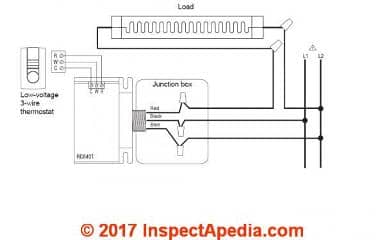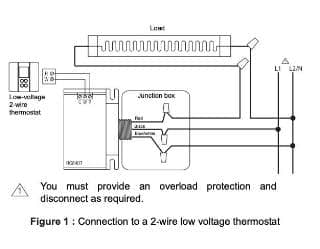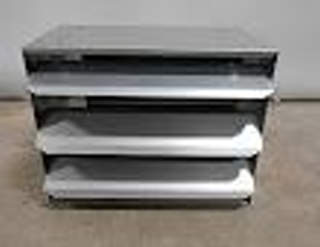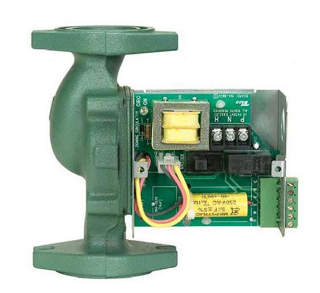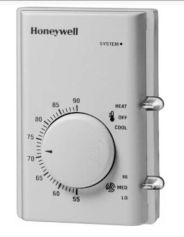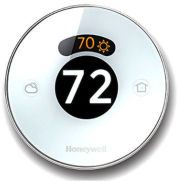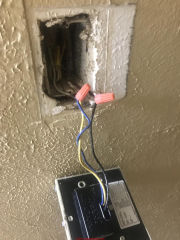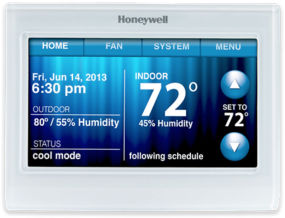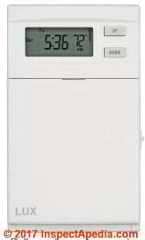 Convert a Line Voltage Thermostat to Low Voltage Nest
Convert a Line Voltage Thermostat to Low Voltage Nest
How to wire a replacement low-voltage thermostat to replace a 120V or 240V control
Aube Technologies Thermostat Guides
- POST a QUESTION or COMMENT about line voltage thermostats
Guide to using a Nest or other Low Voltage Thermostat with a switching relay to replace a line voltage 120V or 240V room thermostat for electric heat, fan heaters, radiant floor heat, convector heaters.
Here we also provide copies of Aube Technologies line-voltage thermostats used for electric heater control, along with company contact information.
This article series describes types of line voltage wall or floor thermostats used to control heating or heating & cooling equipment where switching of 120V or 240V devices is required.
We also provide a more comprehensive INDEX to RELATED ARTICLES for this topic, or you can try the page top or bottom SEARCH BOX as a quick way to find information you need.
InspectAPedia tolerates no conflicts of interest. We have no relationship with advertisers, products, or services discussed at this website.
- Daniel Friedman, Publisher/Editor/Author - See WHO ARE WE?
How to Replace a Line Voltage Thermostat with a Nest® or other Programmable Low-voltage Thermostat
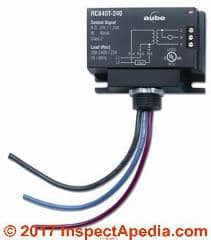 Reader Question: how do I wire a Nest thermostat to a 120V or 240V electric heater?
Reader Question: how do I wire a Nest thermostat to a 120V or 240V electric heater?
2017/01/29 reader (anonymous by private email) wrote:
My current thermostat has 2 wires connected to it coming from the wall.
I researched this and see that this is single pole. I want to replace this thermostat with the Nest.
However, since this voltage currently is 110V/220V, I bought the Aube RC840T-240 to convert it down to 24V so the Nest will work.
How do I connect the 2 wires from the wall to the Aube RC840T-240 that has 3 wires?
Reply:
There should be wiring instructions in with the relay. Typically when a thermostat is controlling only heat the conventional thermostat wires are the red and white wires or R & W wires and the third wire would not be used.
But I don't know you're a specific situation that's why I suggest we need to see the wiring instructions for the product and switching relay you intend to use, in this case the Aube RC840T-240. I will give these below if you don't already have them.
Reader follow-up:
This is the current thermostat [shown above], a Lux Products ELV4 Programmable Line Voltage Thermostat (available at Amazon and from other sources - Ed.)
When I disconnect it, there are only 2 wires connected to it. I know it is single pole, but I don't know if it is 110V or 220V as the thermostat says it is compatible with both. It is not 24V as the wires are thicker.
I've attached the diagram for the AUBE RC840T-240 as well as the actual transformer, but since I only have 2 wires from the wall, I do not understand the diagram and how to hook it up.
Does this make sense? Thanks!
Reply:
Typically R & W are the heating connections in a 24VAC control, and the "C" wire is for cooling.
Electric heating baseboards are usually 240V. A switch is logically simply connecting or not connecting the 240V circuit.
Your original line voltage thermostat (TT) was making or breaking (closing or opening) a single pole single throw on-off switch on a single 240V or 120V wire circuit that powered the electric heater.
Illustrated here: Aube electric switching relay connected to a 3-wire low voltage thermostat.
If you don't already have the instructions for your control, below we provide IO manuals and users' guides for Aube Technologies line voltage Thermostats.
In the AUBE RC840T THERMOSTAT INSTALLATION INSTRUCTIONS [PDF] - retrieved 2017/01/29, original source: http://www.aubetech.com/manuel/2/RC840T.pdf also available from Honeywell Corporation.
Therein, look at Figure #1 - connection to a 2-wire low-voltage thermostat.
They show that you connect the thermostat's R and W terminals (and wires) to the R and W terminals in the AUBE RC840T-240 controller.
That illustration shows how the company expects the heater's wires to be connected as well.
In their example (Figure 1) one 120V line voltage wire L2 goes from the electrical panel to the 2-wire electric electric heater, and the heater's second wire at its "other end" (logically as it's a resistive heater) connects to the RED wire in the AUBE RC840T-240 controller.
In that same figure, the AUBE RC840T-240 controller's BLUE wire connects back to the electrical circuit's L2 (line voltage) wire.
Below is an excerpt from the RC840T installation instructions showing a wiring schematic when connecting to a 2-wire low voltage thermostat and to the electric heater.
Basically the AUBE RC840T-240 controller is switching that wire circuit on and off.
The AUBE RC840T-240 controller's BLACK wire would connect to the OTHER line voltage wire L1 if that wire is present and available to you.
If it's not present I suspect it's not going to be used and you'd cap off that wire with a twist-on connector.
If you're not certain you know how to do this correctly and safely I would contact Honeywell (owner of Aubetech) or aubetch.com directly to ask their tech support what they advise
Watch out: there are risks of death by electrocution
I attach both sets of instructions. You'll see in the WarmlyYours pages when the second line voltage wire comes into use.
- AUBE RC840T THERMOSTAT INSTALLATION INSTRUCTIONS [PDF] - retrieved 2017/01/29, original source: http://www.aubetech.com/manuel/2/RC840T.pdf also available from Honeywell Corporation.
- AUBE RC840T ELECTRIC HEATER SWITCHING RELAY INSTRUCTIONS [PDF] (2017/1/07)
The product is described at"RC840T Series Switching Relay", at http://www.aubetech.com/products/produitsDetails.php?noLangue=2&noProduit=42
This relay is used with 2-wire and 3-wire thermostats.
- NEST THERMOSTAT WIRING for 240V HEAT CONTROL [PDF] when using a switching relay / transformer to control an electric heater through a switching relay, using an example from from WarmlyYours.com a radiant heating company
See our complete collection of line voltage thermostats
...
Reader Comments, Questions & Answers About The Article Above
Below you will find questions and answers previously posted on this page at its page bottom reader comment box.
Reader Q&A - also see RECOMMENDED ARTICLES & FAQs
Q&A on How to Convert a Line Voltage Thermostat to a Nest or Other Low Voltage Thermostat
On 2022-03-12 by Moderator
Thomas, Any added advice to what we've already shared would be arbitrary and dangerous. Call Aube directly as you've still not been able to identify your wires in order to allow someone to give a confident and safe answer to your question.
On 2022-03-10 by Thomas garret
@Inspectapedia Com Moderator, I completely understand and maybe i have been not precise enough or clear enough in my description of my issue. I have no issue bringing an electrician in but I feel that its a pretty simple issue im just not able to figure out..
the aube will be connected to a nest low voltage thermostat it the other wires that i dont know how to connect
As i said the modine has been controlled by an LUX elv4 connected to two wires. The way it was working was by acting as a switch between the line and the heater.
I have no issue connecting the aube to my nest but its the 3 wires connecting the aube to the two wires in the wall that i dont know how to connect
Regardless of what unit I am trying to connect lets say my heater control box only provides one wire to the double 240vol breaker in the electrical panel the other one goes to the heater when the two wires are connected the heater turns on when they are not its off.
How do i connect the 3 wires form the aube to the 2 wires in the box.
On 2022-03-09 by Inspectapedia Com Moderator - Connecting a Nest thermostat to a Modine gas furnace with an Aube relay
@Thomas:
The installation instructions, including wiring diagrams, for the Aube relay about which you ask are given as free PDF downloads above on this page - if you don't already have the instructions for your device you should down load and read them.
You will see that the Aube relay expects to be operated from a low-voltage thermostat, NOT a line-voltage thermostat.
Please understand that I am very nervous about making what can be no more than a GUESS at which of wires you have in hand get connected to which terminals, since if you make a mistake you can get shocked or start a fire.
While there are conventions such as black-hot, white-neutral, and while it's trivially easy to identify wires and power-conducting wires among them using a VOM or DMM (provided you know how t do so), nobody in their right mind would tell someone far away something over-simplified like "just connect the black wire to terminal 1" when they cannot possibly know for sure which wires are in your hand or where they go.
So the burden falls onto you to either read the instructions and become confident that you've correctly identified each of the wires you're connecting, OR hire a trained service technician or electrician to do the work.
It's disappointing for us, too as we really try and want to be helpful, but we're just not going to bet your life and safety on what amounts to wiring up electrical connections while blindfolded.
Electrical wiring instructions for a Modine gas unit heater - as an EXAMPLE - as we don't know the exact model of heater you have - are given at the link I cited earlier, on page 13 of the Modine gas fired unit heater IO manual.
READ THE INSTRUCTIONS - and note what I cited to you before - you can easily find the correct wiring diagram for your heater. Item #2 below.
1. Installation of wiring must conform with local building
codes, or in the absence of local codes, with the National
Electric Code ANSI/NFPA 70 - Latest Edition. Unit must
be electrically grounded in conformance to this code. In
Canada, wiring must comply with CSA C22.1, Part 1,
Electrical Code.
2. Two copies of the unit wiring diagram are provided with
each unit. One is located in the electrical junction box and
the other is suppled in the literature packet. Refer to this
diagram for all wiring connections.
On 2022-03-09 by Thomas
@Inspectapedia Com Moderator, yes sorry its a indeed a gas powered heater and there are a few boxes and cables at the back of the unit which might be low voltage.
however the issue is my thermostat is not positioned close to the heater so i dont know how the people who installed it years ago connected it.
the only thing i know is that the old thermostat which was a LUX elv4 was connected to the only two wires avail in that gang box one black one white with one prob going to the heater and the other to a 240 double breaker.
I would just like to know which wires from the aube connect to the black and the white wire as you said in your other post about the LUX elv4 the old thermostat was just acting as a switch but i can’t figure which of the 3 wires from the aube rc840T-240 connect to which black and white wires in the box.
Thanks for your fast replies btw :-)
On 2022-03-08 by Inspectapedia Com Moderator
@Thomas,
I'll be glad to work further on this but need to start with a clarification.
Your post said you're controlling a Modine GAS furnace 240V.
I could understand controlling a Modine ELECTRIC heater like the one shown below - using 240VAC, and yes Modine produces both electric heaters and gas furnaces-heaters,
but a Gas furnace controlled with a 240V thermostat-switch just doesn't sound right.
This example of a Modine Gas Furnace Manual, the
MODINE PDB / BDP GAS FIRED UNIT HEATER INSTALLATION AND SERVICE MANUAL [PDF] (2021) Model series 6-580.16
makes clear that that heater is controlled by a 24VAC type thermostat.
Shown below: Modine HER - 10 kW - Electric Unit Heater - 240V/60Hz/1 Phase - Horizontal Orientation
Modine says:
Two copies of the unit wiring diagram are provided with
each unit. One is located in the bottom control compartment
access panel and the other is supplied in the literature
packet. Refer to this diagram for all wiring connections.
If you don't have the IO manual for your heater see
MODINE ELECTRIC & GAS HEATERS IO Manuals
On 2022-03-08 by Thomas
@Inspectapedia Com Moderator,
My modine was controlled by LUX elv4 240v line voltage, I then replaced it with a European Nest thermostat that comes with a special relay box that isn’t sold in the US unfortunately
I believe because of the 50hz vs 60hz the thermostat doesn’t always engage the heater so i wanted to switch to the aube + US nest
On 2022-03-06 by Inspectapedia Com Moderator
@Thomas,
Help me out here is I'm a little confused. Why would we be using a 120V or 240V line voltage relay type thermostat on a gas fueled furnace that is usually controlled by a conventional low voltage thermostat?
On 2022-03-06 by Thomas
Hi I saw you replied to a similar question but it wasn’t super clear to me which wire would connect to which wire if you are trying to connect the aube relay with the red black and blue wire to a two wire black and white wall installation ( controlling a modine gas furnace 240v
it seems like the old thermostat was just actin as an interrupter between the line and the modine since there are only two wires ) but I dont know how to connect the wires
On 2022-01-11 by Danjoefriedman (mod)
@Adam BIskup,
You've landed on the right page; do take a look at the article above for a thorough answer.
In short you use a line voltage relay that talks to the nest and talks to the 120V system.
On 2022-01-11 by Adam BIskup
I have old coil heating and cooling system 120v .What can I do to connect Google nest to operate the heat and cool ? thank you
On 2021-12-23 by Inspectapedia Com Moderator
@brian donnelly,
Watch out: while we don't have a clear understanding of what you did, there is risk that your modifications can cause a building fire or dangerous electric shock.
And yes, generally you have to install a switching relay when using a low voltage thermostat to control a line voltage heater, as we explain in the article above on this page.
Please take a look at this article and let me know if any of that leaves you with questions.
On 2021-12-23 by brian donnelly
i have a line voltage thermostat and want to switch to low.I put the 120v line with into a box with a outlet on it.I plugged in a 24v transformer in and connected the two wires to the R and W in my heat only honeywell TH1100DV thermostat.
It doesnt work! Do I need a relay?
On 2021-11-28 by Inspectapedia Com Moderator - Using an Aube relay with a Nest thermostat
@Sarv Atam,
About connecting a line voltage relay to use the Nest thermostat to control electric heat, above on this page we described using the Aube relay and we give links to the Aube installation manuals as downloadable PDFs.
About your photo of wires, it's too dangerous for me to pretend that we can KNOW which wire is doing what based on wire colors at an unknown installation.
There are wiring color conventions, but until someone takes a VOM or DMM to the circuit and/or traces the wires to the heaters they control, it's not a great ida to pretend we know which is which.
The standard line voltage wire colors are
120/208/240 Volt AC Wire Colors
Phase 1 - Black.
Phase 2 - Red.
Phase 3 - Blue.
Neutral - White.
Ground - Green, Green with Yellow Stripe, or Bare Wire.
At an electric heater, using 240V, we need to switch TWO wires ON for heat - that is on a 240V circuit we get 240V across the two hot legs, OR we can get 120V when we connect either leg to neutral.
You might also want to see
NEST THERMOSTAT INSTALLATION & WIRING
LINE VOLTAGE THERMOSTATS for Electric Heaters & Electric Baseboard Heat
Usually there are 2 "hot" wires going to your heater - 1 BLACK & 1 RED - just shown in your sketch.
In essence the separate relay is going to connect those - to turn heat on,
and on the relay's input side are connected the heat on and 24VAC common wires from the low voltage wall thermostat like a Nest.
For other readers, the installation manual for your original ISO-THERM 3000 line voltage thermostat can be downloaded as a PDF
inspectapedia.com/heat/ISO-therm-3000-Thermostat-Manual.pdf
For other readers, the article above on this page describes using the Aube line voltage relay to enable using a Nest Thermostat to control line-voltage electric heat.
an AUBE TH115 A/F/AF programmable thermostat guide [PDF] (2007)
On 2021-11-28 by Sarv Atam
@Inspectapedia Com Moderator, Thank you for your reply, yes i noticed one of the examples covers a similar scenario but I'm somewhat not %100 sure, attached is my current wiring, is there any way you can tell me which cable colors from the Aube go to which ?
On 2021-11-24 by Inspectapedia Com Moderator
@Sarv Atam,
Sure we do exactly that on the page above. An Aube relay, perhaps one of the examples that we give, and you can use the nest thermostat.
On 2021-11-24 by Sarv Atam
Hi, i bought a Google Nest Thermostat without doing much research, not thinking it would not be compatible, looks like i have an old 240V thermostat (ISO-TERM 3000) model IT2503 with 3 wires,
i stumbled upon this site looking for a converter since i can no longer return the thermostat, can you please recommend a relay that will work with my electrical baseboard and Google Nest 3rd Gen?
On 2020-11-13 by (mod) - How to find & wire a digital thermostat to replace an older line-voltage analog thermostat for a 120V water-to-air fan convector
 Rodney,
Rodney,
Good news is there's no construction or mechanical systems problem we will encounter that no one has ever run into before. That means there's almost always a solution.
In this case you want a relay that is sitting between the new thermostat that you want in the line voltage controls. The thermostat switch is the relay and the relay switch is the control.
A nice example is at
CONVERT LINE to LOW VOLTAGE THERMOSTAT
On 2020-11-12 by Rodney - I've been trying to find a digital thermostat to replace the super-innacurate analog thermostat
I have an Water-to-Air Heating Fan Convector, it does hot and cold water, and the water temperature is controlled by the building. The motor has 3 speeds and it looks to run off of wall power (so 110 v or so).
I've been trying to find a digital thermostat to replace the super-innacurate analog thermostat, but all I have found are ones that only have a setting for HEAT but not for COLD.
This analog thermostat is mounted on the wall and only controls on/off once the temp is reached in either hot or cold setting (but y'all know what a thermostat is), and the fan speed is in the convector unit.
What company sells a digital thermostat that runs at 110v that will allow me to replace this analog thermostat, or is there one I can wire directly to the convector that could do hot/cold thermostat, or do hot/cold thermostat with can speeds?
Or a 24v regular digital thermostat that could be wired into the existing 110v wiring?
This Q&A were posted originally
at FAN COIL & FAN CONVECTOR HEATERS & HYDRONIC COILS
On 2020-10-20 by (mod) - how to convert line voltage device or thermostat to use low voltage thermostats
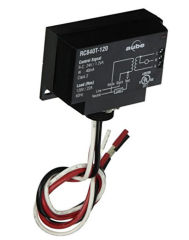 Help:
Help:
I think you're quite right - we addressed this question for another reader near the top of this page and said
Typically when a thermostat is controlling only heat the conventional thermostat wires are ONLY the red and white wires or R & W wires and the third wire would not be used.
For the Aube RC840T-240 give a link to the wiring instructions in the article above in case you don't already have them.
Here we show the relay image cited in Help's message.
On 2020-10-20 by Help with
Long timer reader, first-time poster. I've read through as many posts as possible about this conversion and I could not really find a use case that matches mine. I have an oil burner that feeds three zones ( 3 thermostats, 1 in the basement, 1 in the den, 1 in main floor) the den was an afterthought extension by previous homeowners.
I mention that because once you see the diagram below you might notice additions to the original wiring. I've confirmed that my unit is a 120v unit. I live on Long Island, NY in a house built in the 60s. Running hot water baseboard heaters through the house.
I would like to get either a NEST or Ecobee to replace all three of my thermostats (24v)
Below is a picture of my wiring along with all the other "devices" (apologies for not knowing the terminology) --
I assume I need to add a few (or one) of these : https://www.amazon.com/Technologies-RC840T-120-Electromechanical-Relay-Built/dp/B00D5YLY2G AUBE 120v to 24v transformer, but unsure about the wiring.
I would skip all of this and install the AUBE at the Thermostat but my in wall gang box at each thermostat has 2 wires and the AUBE has 3 so not sure what to do with the third wire, so I figured I'd go down to the boiler and start with the wiring there. I'm open to running new wires IF I absolutely had to.
In addition to the image, you can see the diagram of the wiring here. https://docs.google.com/presentation/d/1A2FUOtfSaOjzue7VE6ZneFykDKuFpQAMNxzqVOEVhcc/edit?usp=sharing
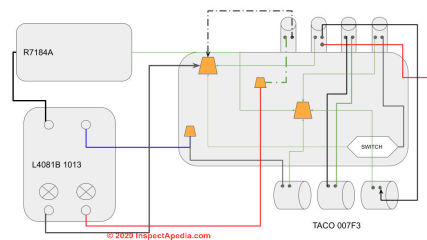
On 2020-07-21 by replace white-rodgers 1A11-2 with nest
Hi, I wanted to replace my old thermostat but when I opened saw that that none of the wires were as descrived in any manual from nest, soon realized that I have a high voltage 120-240 thermostat controller the White-Rodgers 1A11-2.
How can I install my new Nest 3rd Generation? I have 5 wires connected from the thermostat to the wall. two black, one orange, one red, and one orange. Thanks
On 2020-02-04 by (mod) -
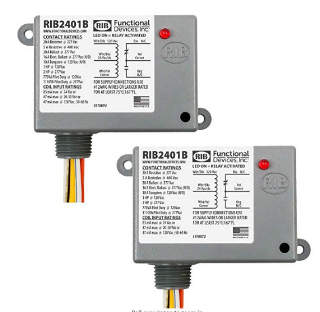 Tim I'm kinda nervous about guessing at making your system work and safe from text and drawings as often there are other on-site features nobody noticed.
Tim I'm kinda nervous about guessing at making your system work and safe from text and drawings as often there are other on-site features nobody noticed.
But the general wiring connections and controls are pretty straighforward, starting with the wiring instructions that come with
- the heater or fan unit
- the relay that, switched by the low voltage thermostat wires, turns the fan unit on or off
On 2020-02-01 by tim planning on hooking up 120v hydronic unit fan with 24v honeywell stat using a rib relay rib2401b.
Would like to have someone check my plan before I do hook it up.
I have a generic hydronic unit in my garage and trying to use what I have for controls.
planning on hooking up 120v hydronic unit fan with 24v honeywell stat using a rib relay rib2401b.
I am thinking hooking line voltage to relay and 24v stat and looping in fan. 24v side of relay to stat and also send 24v signal to taco priority zoning pump r/w contacts to activate pump on call for heat from stat.
I can send my wiring schematic if needed to help view my intention.
thanks
tim
On 2020-01-21 by (mod) -
Honestly I don't think I understand enough about the requirements.
In general I'd not expect to make the garage a priority zone in a home.
and
In general I'd think it'd be easy enough to use an individual TT to set up the garage heater just as you'd set up any other individual zone in a building, using a switching relays to turn on what's needed, circulator & fan for example.
Beyond that general concept I worry that I'll mislead you with a too-specific instruction.
On 2020-01-21 by Anonymous
so do you think sending 24v to priority zoning pump in basement would be the easiest solution.
On 2020-01-20 by (mod) -
Every imaginable zone control setup is given in this Taco guide
https://inspectapedia.com/heat/TACO-Zone-Controls-Wiring-Guide.pdf
On 2020-01-20 by Mike
I guess pic didn't come through first time.
On 2020-01-20 0 by (mod) - The Taco Priority Zoning Circulator
For other readers, "The Taco Priority Zoning Circulator combines the reliability of the 00 circulator with the convenience and efficiency of a PC board-mounted switching relay package.
Each zoning circulator has low and high voltage terminal strips for ease of electrical hookup as well as a built-in priority switch.
The priority switch allows the installer to choose the zone that requires the most attention and, when activated, run only that circulator."
On 2020-01-20 by (mod) -
Neither am I - let's take care not to pretend I know more than I do.
I' thinking about it though.
On 2020-01-20 by Mike
Very cheap hydronic unit. literally a small water coil with a small condenser fan behind it. Didn't even come with any paperwork. Not concerned too much about running before water coil is hot, but what do you mean by thermostat switch? I am very open to your suggestions but I am not sure what you mean by that.
Thanks,
On 2020-01-20 by (mod) - Fan Coil Heater installation guides and wiring diagrams
Ignoring for a moment the idea of running the heater fan in the garage before the fan coil unit is hot, a simple design would have a thermostat switch on both the pump and the fan in response to a call for heat; else you'd need a temperature sensor in the fan coil unit to delay turning the fan on until the heat exchanger is hot.
You might loop your 24V wire as you suggest, but take care that you don't overload the low voltage transformer.
I just looked quickly at six different manufacturers' Fan Coil Heater installation guides and wiring diagrams - there are some suggestions in all of them but I think we ought to find the IO manual for your specific brand and model fan coil heater to see what that manufacturer expects.
Examples of these instructions as PDF downloads are listed below
- CARRIER FAN COIL ACCESSORY ELECTRIC HEATERS WIRING DIAGRAMS [PDF] - All Models, (2013) Carrier Corporation, CAC / BDP D 7310 W. Morris St., Indianapolis, IN 46231 USA Catalog No: WD - FANCOIL - 02
- INTERNATIONAL COMFORT FAN COIL INSTALLATION MANUAL [PDF] - Model: FVM4X "B" Series, (2016) International Comfort Products, Lewisburg TN 37091 USA
- INTERNATIONAL COMFORT HORIZONTAL FAN COIL UNIT WIRING DIAGRAM MANUAL [PDF] - Models FMC4, FMU4, WAMC, WATC, (2017) International Comfort Products, Lewisburg TN 37091 USA
- MARITIME GEOTHERMAL AHW SERIES HYDRONIC AIR HANDLER INSTALLATION & SERVICE MANUAL [PDF] - Model Size 65 Fan Coil Unit, Maritime Geothermal Ltd. Maritime Geothermal Ltd. P.O. Box 2555 Petitcodiac, N.B. E4Z 6H4 Canada, Tel. (506) 756-8135 Email: info@nordicghp.com Web: www.nordicghp.com
- SUPERIOR REX VERTICAL FAN COIL UNIT RAV INSTALLATION & OPERATION MANUAL [PDF] - Models RAVs, RAVE, RQAVM, Superior Rex, Website: www.superiorrex.com
- TITUS THH HIGH PERFORMANCE HORIZONTAL FAN COIL UNITS [PDF] - Titus HVAC, 605 Shiloh Rd Plano TX 75074 USA, Tel: 972.212.4800 Website: www.titus-hvac.com
Also see
- MANUALS & PARTS GUIDES - HVAC - home - Master Index to All Brand Names & HVAC manuals, wiring diagrams, installation and repair guides
- MANUALS for HEATING & A/C SYSTEM CONTROLS
On 2020-01-20 by Mike
The hydronic fan coil in garage is being supplied hot water by pump in basement. I have 120v in both areas (garage and basement) but only 24v wires to tie the two together. I have a taco priority zoning pump or a taco non priority pump available to use.
I would like to use the non priority pump and am wondering the best way to control the operation of that pump using only the 24v wires between the pump in the basement and the fan coil in garage.
I was thinking of feeding 24v from basement transformer to stat in garage and then looping the pump in the basement for this with another RIB relay. Only because I already have the additional RIB relay available. Or, just using Taco priority zoning pump and tie that to the stat in the garage.
Hope that makes some sense.
Look forward to your thoughts.
Thanks,
On 2020-01-19 by (mod) - RIB2401B 20A switching relay to operate a 120VAC fan coil heater
 Mike
Mike
I am sure I don't have the full picture nor understanding but in general it sounds as if you have two separate applications:
1. Operating a 120VAC garage fan coil heater by installing a Honeywell 24VAC thermostat that is in turn wired to a RIB2401B 20A switching relay that is made by Functional Devices, using the relay to turn the fan coil on and off.
That's perfectly reasonable, though you might see if a Honeywell line voltage thermostat set-up would be easier and less costly.
2. Operating a basement pump from a location where you only have low voltage running to the basement.
You can run the pump by using another switching relay located in the basement where you have 120VAC wiring already to your pump, switching the relay by your low-voltage wires that run from the switching relay up to whatever switch or control you intend to use to run the basement pump (what sort of pump and for what application I don't know).
For other readers, Mike's relay is a
24-V Switching Relay, RIB2401B, enclosed relay, 20 amp SPDT with 24 VAC/DC/120 VAC coil.
Made in United States by Functional Devices, Inc. 101 Commerce Drive, PO Box 437 Sharpsville, IN 46068 USA, Tel: (800) 888-5538, Technical Support: support@functionaldevices.com or Sales: sales@functionaldevices.com
Illustrated below from the company's web page: https://www.functionaldevices.com/products/building-automation/details/RIB2401B/
See this
RIB2401B 24V SWITCHING RELAY SPECIFICATION SHEET [PDF] at https://inspectapedia.com/electric/24VAC-Relay-Functional-Devices-RIB2401B-specifications.pdf
On 2020-01-19 1 by Mike
I have a hydronic fan coil for my garage that runs off of 120v. I would like to control that with a rib2401b and a 24v honeywell stat. Second item, I also have to turn a pump on in the basement and only have a 24v wire to do so.
My question is can I run power to fan including the RIB relay. I was planning on having the RIB between the 24v stat and the 120v fan circuit. Feeding the stat with a transformer from the basement and including taco priority zoning pump or non priority pump if possible.
Feed back would be greatly appreciated.
Thanks
On 2020-01-16 by (mod) -
Ah of course, thanks.
On 2020-01-16 by Rich
It might be easier to control the UV light with another switch that can listen to Alexa.
On 2020-01-16 by Anonymous
The Nest Learning Thermostat has terminals for 3 fan speeds and instructions for using same if that’s what you mean by 3 stages.
They are controlled in Settings. You set what you want to be ‘normal’ then change the fan speed in the App or at the thermostat if you want to change the speed.
On 2020-01-15 by (mod) -
Rich
That's really interesting and probably beyond the scope of imagination of the Nest thermostat engineers, particularly, I'm unclear how one thermostat is going to recognize what amounts to 3 zones.
Or you could use multiple smart thermostats, Nests or others.
I've been experimenting with several of the many alternative "smart switches" on the market that can turn off 120VAC circuits, receptacles etc. using a smartphone app. Wyze is an example. You can set rules to operate a particular switch such as time of day (but no direct connection to thermostat);
On 2020-01-15 by Rich B
In addition to the basics explained before in regard to wiring a Nest Learning thermostat to a high voltage system, I want to use the Nest to set the fan speed of which there are 3. This is a cooling only fan coil system. The fan coil unit is new, high voltage, and has a motor with 3 speed settings.
I'm thinking I need a relay for each fan speed so that the Nest can switch the relay for the particular speed I want for the fan. This is addition to a low voltage transformer to run the Nest. The Nest will also require a low voltage relay to run the system.
Is this correct?
On 2019-11-19 by (mod) - Is it necessary to replace the wire when converting to a low voltage thermostat from a high voltage thermostat?
Steve:
You cannot use low-voltage wiring for a line voltage thermostat so yes you'll need new thermostat wiring.
However you can leave the old low-voltage wires in place in the wall - As long as we are sure that there is no high voltage connected anywhere to the wires now being used to operate the low voltage Thermostat.
However you will also need to install a junction box or suitable enclosure to give room to splice on to each end of the old high voltage wire the smaller gauge copper thermostat wires that you'll need to connect to the thermostat terminals - those larger #12 or #14 copper wires won't fit in the little terminals on the low voltage thermostat.
The low voltage thermostat connectors AND the connectors on heating controls at the other end that are expecting low voltage will be sized for #18 copper - lots smaller.
On 2019-11-18 by Steve
Is it necessary to replace the wire when converting to a low voltage thermostat from a high voltage thermostat? I am referring to the wires from the New low voltage thermostat to the relay/transformer
On 2019-08-15 by EHack
Can I convert this thermostat to a low voltage to use with an ecobee?
HONEYWELL T6380 SERIES ELECTRONIC FAN COIL THERMOSTATS [PDF] Honeywell Controls, retrieved 2020/01/16 original source: https://customer.honeywell.com/resources/Techlit/TechLitDocuments/95C-00000s/95C-10758.pdf
Excerpt: The T6380 series of electronic fan coil thermostats provide
precision line voltage control of fan-forced Heating, Ventilating and Air Conditioning equipment. Models are available for
cooling-only, manual heat-cool changeover, or remote heatcool changeover systems.
Hydronic source heat-cool
systems may be two or four-pipe configuration with 0, 1, or 2
valves.
Fan control options include constant, cycled, or userselectable "On-Auto" operation. Manual fan speed selection
is standard. All models feature an “Off” switch.
On 2019-07-01 by (mod) -
As you know, the Honeywell T6169B4017 (shown later in this note) is a fan-coil thermostat operating on line voltage.
Shown here: Honeywell Home Lyric Smart Thermostat RCH9310WF (second generation).
The Honeywell 9000 is a 20-30 VAC operated thermostat. You understand that you would not connect this thermosat directly to line-voltage (120VAC).
I can imagine several options, of which neither of the first two is very attractive:
1. Connect the run wire (probably white) to both heating and cooling TT controls on your separate heater and air conditioner, and RELY ON MANUALLY SWITCHING the un-wanted system OFF seasonally so as not to run both at once. There are additional technical issues like differences in circuit resistance and ampacity.
2. Technically clean and correct but more-trouble: run a new TT wire from the mechanicals area in your home up to the new wall thermostat so that you'll have enough control wires.
3. Try a different line-voltage thermostat
See either of these two cross-reference guides:
- HONEYWELL FAN COIL THERMOSTAT QUICK REFERENCE GUIDE - CROSS REFERENCE CARD [PDF] Honeywell Controls, retrieved 2020/01/16 original source: https://customer.honeywell.com/resources/Techlit/TechLitDocuments/67-0000s/67-7080GW.pdf
- HONEYWELL COMMERCIAL THERMOSTAT APPLICATION SELECTION & CROSS REFERENCE GUIDE [PDF] Honeywell Controls, retrieved 2020/01/16 original source: https://customer.honeywell.com/resources/Techlit/TechLitDocuments/63-0000s/63-9610.pdf
- Also see LINE VOLTAGE THERMOSTATS
4. Convert to a wireless thermostat that operates over WiFi. There are at least six popular options currently available including
- Honeywell Lyric Thermostat shown above, a
Honeywell Wi-Fi Smart Thermostat
Also see these Honeywell thermostat IO Manuals- HONEYWELL Lyric Round™ WI-FI THERMOSTAT INSTALLATION GUIDE [PDF] Honeywell Controls, retrieved k2020/01/16 original source: https://forwardthinking.honeywellhome.com/related_links/thermostats/lyric/Professional_Installation_Guide.pdf
- HONEYWELL Wi-FI Thermostat 9000 INSTALLATION GUIDE [PDF], Honeywell Controls, retrieved k2020/01/16 original source: https://customer.honeywell.com/resources/Techlit/TechLitDocuments/69-0000s/69-2815EFS.pdf
- THERMOSTAT WIRING HONEYWELL full set of PDF downloads
- Sensi Wi-Fi Thermostat
- Nest Learning Thermostat – 3rd Generation T200577
- Ecobee3 Smarter Wifi Thermostat
On 2019-06-29 by Jeremy
Hi after pulling the old tstat off the wall I see the have combined the heat and cool call wires together in a dumb tstat like this one
I can understand but since the new unit will place the heating and cool calls on different wires how do I handle this ? Just combine them also and change the mode of the unit when it’s time? Thanks
Hi I live in an apartment MDU where it’s a chiller/boiler system water pipes in walls,controlled by the front office and is currently line volt tstat with 3 wires heat/off/cool I can flip it to heat and still get AC on as the office didn’t change over their side
I understand how these relays work for heating only but when the office flips to a different mode
I’m unsure how to wire the low Voltage unit so it knows when it reaches the set point to make/break the circuit the old tstat is a 3 wire Honeywell T6169B4017 (shown above) It has purple yellow black wires
Hooking in a reply with 24v step down seems simple enough but how do i handle the fact i am not in total control of the system mode and yes the apt complex let me sign off saying as long as I give the old tstat they are happy lol
I want to replace with a Honeywell 9000 Wi-Fi porgrammable thermostat (shown below).
Any input would be much appreciated
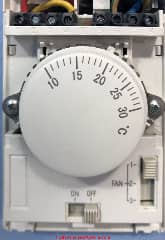 On 2019-04-26 by (mod) - convert a Honeywell t6373a1108 thermostat on a high voltage circuit to use a Nest Thermostat
On 2019-04-26 by (mod) - convert a Honeywell t6373a1108 thermostat on a high voltage circuit to use a Nest Thermostat
Anon
It is indeed possible to convert a line voltage thermostat-controlled heater to use a low voltage room thermostat.
The basic approach is to buy a switching relay that is operated by the low-voltage thermostat and that in turn turns on the 120VAC or 240VAC heaters.
You replace the line voltage thermostat with the switching relay, then add low voltage wire from a transformer to power the Nest or other low-voltage thermostat. Wires from the low voltage thermostat simply run to and turn on or off the switching relay.
The article above on this very page adds details to that procedure, provides wiring diagrams for a Nest (a PDF file) and gives examples of the products you'll need.
Please review that information and then don't hesitate to ask if you have further questions.
On 2019-04-26 by Anonymous
hi I have a Honeywell t6373a1108 thermostat on a high voltage circuit with five wires connected to it, I would to know how I can convert it to low voltage so i can put a Nest thermostat, I will attach an image of the thermostat with the wiring exposed, help would me much appreciated
On 2018-12-22 by Dave J
- thank you !!!
On 2018-12-20 by (mod) - how to identify the wires when wiring up the Aube RC840 relay or similar line voltage heat switching relays
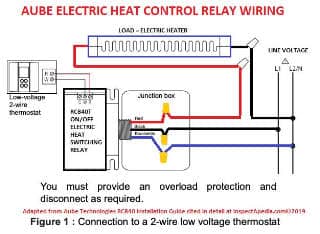 I'm a bigger dope so don't worry Dave.
I'm a bigger dope so don't worry Dave.
I think what we had in the old thermostat was
L1 (black) this is line voltage in - 120VAC
L2 (red) this is line voltage in - 120VAC
Those two wires, taken together are bringing 240VAC to the electric heater
LOAD (Black) is the wire from the heater
LOAD (Red) is the second wire from the heater
The original thermostat or switch, on a call for heat, connects L1 to LOAD 1 and simultaneously connects L2 to LOAD 2.
In sum the relay is ONLY switching ONE live voltage wire - such as for an electric heater using 120VAC.
Take a look at the wiring diagram in the
AUBE RC840T RELAY INSTALLATION MANUAL [PDF] at https://inspectapedia.com/heat/Aube-RC840T-Relay-Installation-Manual.pdf- orignal source, Honeywell Corp. at https://customer.honeywell.com/resources/techlit/TechLitDocuments/69-0000s/69-2562EF.pdf
You can give the manufacturer a call at their help line or contact
Aube / Honeywell
705 Montrichard Avenue
Saint-Jean-sur-Richelieu, Quebec
J2X 5K8
Canada
1-800-831-2823
Email: aube.service@honeywell.com
Website:
www.aubetech.com
Other readers who purchased the AUBE RC840 relay - like the RC840T above but without the built-in transformer, here is that IO Manual
AUBE RC840 RELAY INSTALLATION MANUAL [PDF]
The RC840 Electric Heating Relay is designed to control a line
voltage resistive load from a 24 V control signal.
On 2018-12-20 by Dave J
Folks, I'm trying to replace an AUBE PB112-240D line voltage thermostat with a Nest for baseboard heating (no cooling) -
I have an AUBE RC840T-240 relay to connect to the baseboard wiring and then connect the Nest.
My question (and it's probably so basic I look like an idiot) -
there are 4-wires in the old Thermostat -
LOAD (Black), L1 (Black),
L2 (Red) and LOAD (Red)
- there are 3 wires on the relay -
Red, Black, Blue.
According to the manual, Black maps to L1, Blue to L2 but what about the
TWO LOAD wires (remaining Black and Red) ? Have I got the right Relay ?
Regards
Dave
On 2018-12-01 by Mike
Will the Sube rc840 t convert line to low voltage thermostat work on the Honeywell smart color thermostat which is a 24 volt thermostat. ?
On 2018-02-23 by (mod) -
Stacy
You cannot directly connect a line voltage thermostat to a nest. You need an intermediate device such as we discussed in the article above on this page.
On 2018-02-23 by Stacy
Trying to install a NEST thermostat with a BIASI condenser boiler that has a two wire line voltage thermostat. How do you connect this to a transformer switch for low voltage. Most diagrams show a three wire 120 V coming from the boiler, how would you wire this with only two wires?
On 2018-01-22 by DDS
I'd like to suggest to whom wants to apply a NEST to 'high voltage' system to buy the european version. It also can control hot water cylinder (but not cooling).
It'll work both with 110/240V AC 50/60Hz and has the plus of not needing ti be mounted where the old t.stat was. (it communicates wirelessy and need just a micro-usb power unit). Table stands are available.
So you have to connect the heat-link to old t.stat connections and put the 'screen' wherever you like.
...
Continue reading at LINE VOLTAGE THERMOSTATS - topic home, or select a topic from closely-related articles below, or see our complete INDEX to RELATED ARTICLES below.
Or see these
Recommended Articles
- COMMON WIRE at THERMOSTATS
- CONVERT LINE to LOW VOLTAGE THERMOSTAT
- ELECTRIC BASEBOARD HEAT INSTALL
- ELECTRIC HEAT
- LINE VOLTAGE THERMOSTATS
- MANUALS & PARTS GUIDES - HVAC - home
- NEST THERMOSTAT INSTALLATION & WIRING STEPS
- THERMOSTAT POWER & VOLTAGE
Suggested citation for this web page
CONVERT LINE to LOW VOLTAGE THERMOSTAT at InspectApedia.com - online encyclopedia of building & environmental inspection, testing, diagnosis, repair, & problem prevention advice.
Or see this
INDEX to RELATED ARTICLES: ARTICLE INDEX to HVAC THERMOSTATS
Or use the SEARCH BOX found below to Ask a Question or Search InspectApedia
Ask a Question or Search InspectApedia
Try the search box just below, or if you prefer, post a question or comment in the Comments box below and we will respond promptly.
Search the InspectApedia website
Note: appearance of your Comment below may be delayed: if your comment contains an image, photograph, web link, or text that looks to the software as if it might be a web link, your posting will appear after it has been approved by a moderator. Apologies for the delay.
Only one image can be added per comment but you can post as many comments, and therefore images, as you like.
You will not receive a notification when a response to your question has been posted.
Please bookmark this page to make it easy for you to check back for our response.
IF above you see "Comment Form is loading comments..." then COMMENT BOX - countable.ca / bawkbox.com IS NOT WORKING.
In any case you are welcome to send an email directly to us at InspectApedia.com at editor@inspectApedia.com
We'll reply to you directly. Please help us help you by noting, in your email, the URL of the InspectApedia page where you wanted to comment.
Citations & References
In addition to any citations in the article above, a full list is available on request.
- [2] "The Nest Learning Thermostat", Nest Thermostat, 900 Hansen Way Palo Alto, CA 94304, Tel: 855-4MY-NEST, Email: info@nest.com, website http://www.nest.com/, retrieved 1/24/2013.
- [3] Honeywell Controls, the company wants you to use their contact form at this web page: http://www51.honeywell.com/honeywell/contact-support/contact-us.html
Honeywell Consumer Products, 39 Old Ridgebury Road Danbury, CT 06810-5110 - (203) 830-7800
World Headquarters, Honeywell International Inc., 101 Columbia Road, Morristown, NJ 07962, Phone: (973) 455-2000, Fax: (973) 455-4807 1-800-328-5111 - [4] Honeywell Corporation, Honeywell T451A, T651A, T694A,B,D,F Light Duty Line Voltage Thermostats, [installation, troubleshooting manual], 1992, Honeywell Consumer Products,
39 Old Ridgebury Road Danbury, CT 06810-5110 - (203) 830-7800 copy on file as Honeywell_Line_Voltage_T651A.pdf
World Headquarters, Honeywell International Inc., 101 Columbia Road, Morristown, NJ 07962, Phone: (973) 455-2000, Fax: (973) 455-4807 1-800-328-5111 copy on file as Honeywell_Line_Voltage_T651A.pdf
"T451, T651, T694 Thermostats provide on-off control of valves, fans, motors, contactors, electric heat elements, duct furnaces and fan coil units in heating/cooling systems. Switching sub-bases provide manual control of heating, cooling and fan." - [5] Honeywell Corporation, "Honeywell Thermostats", website http://www.honeywell-thermostat.com/line-voltage.html retrieved 3/16/13
- [6] Honeywell EConnect™ Wireless Thermostat Kit TL9160AR System Installation Guide, retrieved 3/15/13, copy on file as Honeywell_EConnect69-2474EFS.pdf
- [7] Trane, Ingersoll Rasnd Residential Solutions, Trane PO Box 9010, Tyler TX 75711, Website www.trane.com
- [11] White Rodgers Thermostats and HVAC controls,
Homeowner information: http://www.emersonclimate.com/en-US/brands/white_rodgers/Pages/wr-homeowner-info.aspx
Contractor information: http://www.emersonclimate.com/en-US/brands/white_rodgers/wr_contractor_info/Pages/white-rodgers-contractor-info.aspx
White Rodgers Product Catalog (don't misspell the company's name as White Rogers Thermostats) -
http://www.emersonclimate.com/Documents/thermostats.pdf - Thermostat Catalog - [12] Domestic Central Heating Wiring Systems and Controls, 2d Ed., Raymond Ward, Newnes, ISBN-10: 0750664363, ISBN-13: 978-0750664363, Quoting from Amazon.com:
This unique A-Z guide to central heating wiring systems provides a comprehensive reference manual for hundreds of items of heating and control equipment, making it an indispensable handbook for electricians and installers across the country. The book provides comprehensive coverage of wiring and technical specifications, and now includes increased coverage of combination boilers, recently developed control features and SEDBUK (Seasonal Efficiency of Domestic Boilers in the UK) boilers ratings, where known.
In addition to providing concise details of nearly 500 different boilers fuelled by electric, gas, oil and solid fuel, and over 400 programmers and time switches, this invaluable resource also features numerous easy-to-understand wiring diagrams with notes on all definitive systems. Brief component descriptions are provided, along with updated contact and website details for most major manufacturers. - Our recommended books about building & mechanical systems design, inspection, problem diagnosis, and repair, and about indoor environment and IAQ testing, diagnosis, and cleanup are at the InspectAPedia Bookstore. Also see our Book Reviews - InspectAPedia.
- In addition to citations & references found in this article, see the research citations given at the end of the related articles found at our suggested
CONTINUE READING or RECOMMENDED ARTICLES.
- Carson, Dunlop & Associates Ltd., 120 Carlton Street Suite 407, Toronto ON M5A 4K2. Tel: (416) 964-9415 1-800-268-7070 Email: info@carsondunlop.com. Alan Carson is a past president of ASHI, the American Society of Home Inspectors.
Thanks to Alan Carson and Bob Dunlop, for permission for InspectAPedia to use text excerpts from The HOME REFERENCE BOOK - the Encyclopedia of Homes and to use illustrations from The ILLUSTRATED HOME .
Carson Dunlop Associates provides extensive home inspection education and report writing material. In gratitude we provide links to tsome Carson Dunlop Associates products and services.


